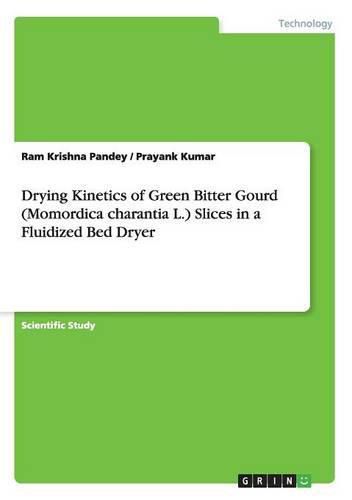Readings Newsletter
Become a Readings Member to make your shopping experience even easier.
Sign in or sign up for free!
You’re not far away from qualifying for FREE standard shipping within Australia
You’ve qualified for FREE standard shipping within Australia
The cart is loading…






Scientific Study from the year 2015 in the subject Engineering - General, Basics, language: English, abstract: Green Bitter gourds (Momordica charantia L.) belong to ‘cucurbitacceae’ family and are commonly called as bitter gourd, papailla, karalla, balsam apple and balsam pear etc. in different part of the world Bitter gourd contains an array of biologically active plant chemicals including triterpenes, protein and steroids. Bitter gourd have extremely low amount of calories but have a lot of valuable nutrients. In India, bitter gourd stored in the dried form. The indigenous practice is to dry the sliced vegetable in sun during October-November and used up to the month of May. However, the quality of the dried product is rather poor. Experiment were conducted in TNAU fluidized bed dryer to study the drying characteristic of green bitter gourd slices at five level of temperature (50,55,60,65,700C), five level of sample (100,125,150,175,200 g) and three level of air velocity (1.5,2,2.5 m/sec). Bitter gourd slice was dried in hot air dryer. Moisture loss data were recorded periodically at an interval of five minutes for the first forty minutes and consequently fifteen minutes intervals. Quality characteristics of bitter gourd slice were determined in terms of rehydration ratio, color, ash content. The data were analyzed to study drying characteristics of a bitter gourd. The effect of various factors was analyzed using analysis of variance (ANOVA) technique. Second order model was fitted in the responses and independent variables using regression analysis. The drying behaviour of Bitter gourd was mathematically analyzed using Page’s, Logarithmic and Exponential models. The goodness of fit of the model was tested using coefficient of determination (R2), and standard error of estimate (SEE). The effect of drying temperature, air velocity, sample weight and their interactions were significant on drying time at 5% level of significance. Logarithmic model was found to de
$9.00 standard shipping within Australia
FREE standard shipping within Australia for orders over $100.00
Express & International shipping calculated at checkout
Scientific Study from the year 2015 in the subject Engineering - General, Basics, language: English, abstract: Green Bitter gourds (Momordica charantia L.) belong to ‘cucurbitacceae’ family and are commonly called as bitter gourd, papailla, karalla, balsam apple and balsam pear etc. in different part of the world Bitter gourd contains an array of biologically active plant chemicals including triterpenes, protein and steroids. Bitter gourd have extremely low amount of calories but have a lot of valuable nutrients. In India, bitter gourd stored in the dried form. The indigenous practice is to dry the sliced vegetable in sun during October-November and used up to the month of May. However, the quality of the dried product is rather poor. Experiment were conducted in TNAU fluidized bed dryer to study the drying characteristic of green bitter gourd slices at five level of temperature (50,55,60,65,700C), five level of sample (100,125,150,175,200 g) and three level of air velocity (1.5,2,2.5 m/sec). Bitter gourd slice was dried in hot air dryer. Moisture loss data were recorded periodically at an interval of five minutes for the first forty minutes and consequently fifteen minutes intervals. Quality characteristics of bitter gourd slice were determined in terms of rehydration ratio, color, ash content. The data were analyzed to study drying characteristics of a bitter gourd. The effect of various factors was analyzed using analysis of variance (ANOVA) technique. Second order model was fitted in the responses and independent variables using regression analysis. The drying behaviour of Bitter gourd was mathematically analyzed using Page’s, Logarithmic and Exponential models. The goodness of fit of the model was tested using coefficient of determination (R2), and standard error of estimate (SEE). The effect of drying temperature, air velocity, sample weight and their interactions were significant on drying time at 5% level of significance. Logarithmic model was found to de